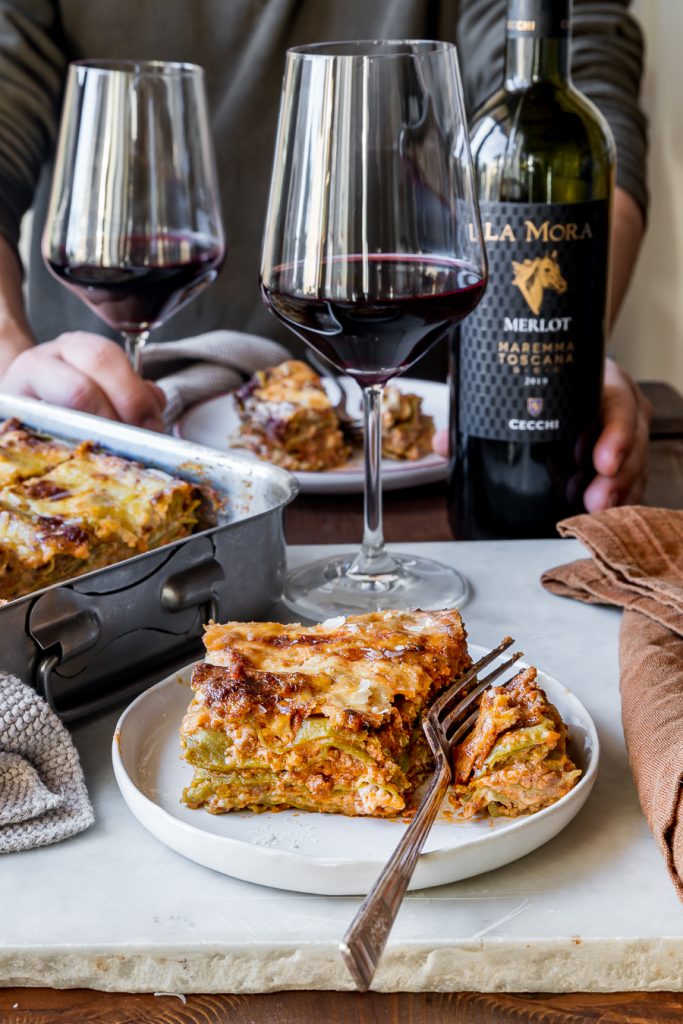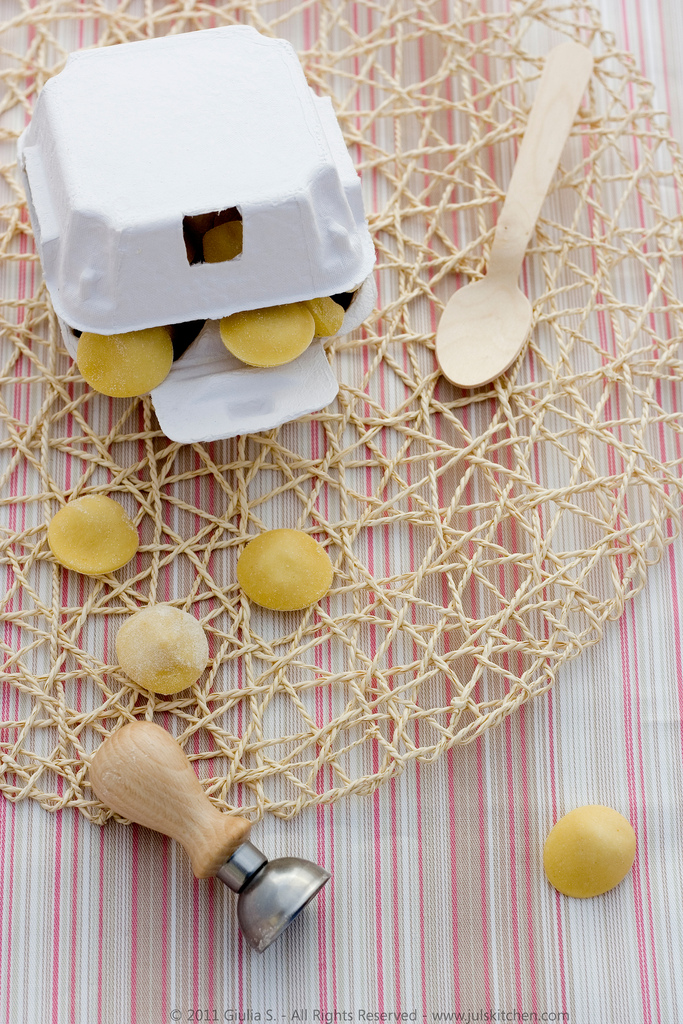How to make lasagne alla bolognese
This year there will be more fresh pasta recipes here on the blog, I told myself as I rolled out the green spinach sheets for the lasagne alla Bolognese we ate to celebrate with my family the first day of the year.
Until last year I used to make fresh pasta at least two or three times a week, thanks to my cooking classes: ravioli, tortelli, tagliatelle and tagliolini, and especially pici. Then pregnancy and the pandemic took over, and we suspended the classes. I almost stopped making fresh pasta, leaving it only for special occasions or for a few recipes to test for the blog, or for some clients.

This year, searching for a new normality, I decided to include fresh pasta in my good intentions, or rather, in my daily rituals, in the gestures that I want to make essential, fluid, an anchor to the present, to the here and now.
During these festive days, I have been cooking a lot, testing recipes for our next cookbook and dedicating myself to the classics of Italian cuisine, such as lasagne alla Bolognese.
There’s a sense of comfort in cooking traditional recipes: it is a taste that is part of our DNA, a sparkle that awakens shared memories of happiness and family. You feel also a sense of relief, because you realize that everything already works perfectly, from the ingredient pairing to the textures. Innovation and experimentation are always welcomed in my kitchen, even though they are certainly not my signature traits. Every now and then, though, it is good to rely on what others have already fine tuned for us, trusting a traditional recipe and sending gratitude to the universe and to the array of home chefs that have cooked that dish for years, or centuries, creating a classic.

Lasagne alla bolognese, with ragù Bolognese, béchamel sauce and Parmigiano Reggiano
Recipe developed in collaboration with Cecchi.
The history of the Cecchi family began in 1893 with Luigi Cecchi, an extremely talented wine taster. The Cecchis soon became famous abroad for their skills. In the 1970s they moved to Castellina in Chianti, in the area historically famous for the production of Chianti Classico, and there they began their wine making adventure. In the following years, they expanded their production areas as to include San Gimignano, where they produce a renowned local white wine, Vernaccia, and Maremma.
Cecchi was one of the pioneers of wine production in Maremma, where they make one of the most representative local wines, Morellino di Scansano, and a Merlot.
La Mora Merlot is the wine that inspired today’s recipe. It has all the varietal characteristics and those of Maremma where it grows, with an intense, deep purple red hue. Perfectly balanced, fruity, and complex, La Mora is a silky wine rounded out with fine and velvety tannins. It is a perfect pairing for pasta dishes with robust meat sauces or game, but also for grilled meats. Given the festive climate, I immediately thought of lasagne. Given my desire for classics, I opted for lasagne alla Bolognese, to start the year off on the right foot.

The ingredients of lasagne alla Bolognese
Besides spinach lasagne sheets and a proper ragù Bolognese, we stick to the classics. A soft béchamel sauce, scented with nutmeg, and a shower of grated Parmigiano Reggiano. These are the essential ingredients of lasagne Alla Bolognese. Ricotta is not a traditional ingredient in the classic lasagne alla Bolognese.
Fresh pasta
To make lasagne alla Bolognese by the book, you should use fresh spinach lasagne sheets, as per the Emilian tradition. Kneaded with fresh eggs and spinach and rolled out very thinly, they are cooked for less than a minute in boiling water. It is important to pass them immediately afterwards under cold water and dry the excess moisture on a clean cloth. They look delicate, but once cooked, they gain strength and, as a consequence, they are the backbone of the lasagne.
Here you can find a recipe to make tagliatelle paglia e fieno, hay and straw tagliatelle, another classic sporting fresh spinach pasta as a key ingredient.
The ragù
The ragù is the Bolognese sauce, which is different from my family Tuscan ragù. In the Bolognese ragù you use a dry white wine instead our robust Chianti red wine, a smaller amount of vegetables than in my grandmother’s meat sauce, and, above all, you pour in the pot a glass of milk, which softens the acidity of the tomatoes. What this ragù has in common with ours, though, is the use of mixed ground meat, not only beef but also pork, for a good amount of fat, and a slow. long simmering. I’m talking about hours.

Patience and moderation
I learnt about the importance of these ingredients from my grandmother. They are the key to perfectly replicating her lasagne, or pasta al forno, as we call it. They can certainly be applied to lasagne alla Bolognese as well.
You need patience, in kneading and resting the fresh pasta, rolling out the lasagna sheets, cooking and drying them. It takes patience to prepare a proper ragù, in which all the flavours blend with time. But above all, it takes patience to wait, because for me lasagne always tastes much better the next day.
Moderation comes into play when making lasagne, when smearing ragù and béchamel sauce layer upon layer, along with with spinach lasagne sheets and grated Parmigiano Reggiano. Until a few years ago, I used to think that more béchamel and meat sauce automatically made a better lasagne, but every time I got a lasagne that was too heavy, or greasy.
Now I’ve realised that the right amount of ingredients produces a result that goes far beyond what you might expect from applying the word moderation to cooking: the lasagne is thick, you can easily slice it, and it has just the right amount of creaminess, taste and flavour.
It’s amazing how much you can learn from a simple pan of lasagne.

Ragù Bolognese
Ingredients
- 1 onion
- 1 carrot
- 1 celery stalk
- 2 tablespoons extra virgin olive oil
- 20 g butter
- 400 g ground beef
- 250 g ground pork
- 150 g ground pork belly
- ½ cup dry white wine
- 1 cup whole milk
- 500 g tomato puree
- 2 tablespoons tomato paste
- Salt
- Freshly ground black pepper
Instructions
- Using a good sharp knife, make battuto, that is finely mince the onion, carrot, and celery. If you prefer to use a food processor, do it in several rounds: First process the celery and carrot together, then the onion, just enough to finely shred it. Be careful not to reduce the onion to a mush.
- Cover the bottom of a pot with extra virgin olive oil. Add the butter and finely chopped vegetables, along with a generous pinch of salt—this will help you cook the vegetables without burning them, as the salt will extract the moisture from the vegetables.
- Cook over low heat for about 10 minutes, stirring often. The battuto should be happily sizzling; do not burn it or let it darken too much. Now that the battuto has been sautéed in olive oil, we call it a soffritto.
- Move the pot to a medium heat and add the ground beef, pork and pork belly. Stir with a wooden spoon to break the meat into smaller pieces and mix it into the soffritto. Stir continuously, using the wooden spoon to scrape the meat from the bottom and the sides of the pot. The meat will release some liquid, so cook it until the liquid has been completely absorbed and the meat is nicely browned. It will take at least 20 minutes.
- Now gradually pour in the white and reduce it completely.
- When you no longer smell the alcohol, pour in the milk and let it reduce, stirring occasionally, over medium heat.
- Season with salt and pepper.
- Add the tomato purée and the tomato paste, diluted in a cup of hot water, stirring thoroughly. The ragù will begin to sputter. Cover the pot and simmer slowly, on the lowest heat.
- Cook for at least an hour and a half, even two hours, stirring from time to time. You will notice puddles of olive oil forming on the surface of the meat sauce, coloured red by the long cooking time with the tomato sauce. This is when the ragù will be ready.

Lasagne alla bolognese
Equipment
- 20x30cm (11- x 15-inch) baking dish
Ingredients
Homemade spinach lasagne sheets
- 200 g 00 flour, or all-purpose flour
- 50 g spinach, already cooked and well-drained
- 1 egg
- 1 teaspoon extra virgin olive oil
- 1 pinch salt
Béchamel sauce
- 60 g flour
- 60 g butter
- 1 l whole milk
- Salt
- Nutmeg
Other ingredients
- 1 batch Ragù Bolognese
- 100 g Parmigiano Reggiano, grated
- 30 g butter
Instructions
Have the ragù Bolognese ready.
Make the homemade spinach lasagne sheets.
- Pour the flour on a wooden working surface and shape into a mound with a large well in the centre. Crack in the egg, then add the finely minced spinach. Pour in the olive oil and add a pinch of salt.

- Using a fork, stir slowly, starting from the centre and gradually picking up more flour from the edges, whisking as if you are beating eggs for an omelette. When the dough turns crumbly, switch to kneading with your hands.
- Continue kneading the ball of dough until the gluten starts to develop, as this will render the sheets of pasta stronger. When the ball of dough is smooth, silky, and no longer sticky, wrap it in plastic wrap, or cover with a bowl, then let rest for 30 minutes at room temperature before using it.
Prepare the béchamel sauce.
- Melt the butter in a saucepan over medium heat. When melted, spoon in the flour and whisk for a few minutes until golden and toasted. Pour in the cold milk in a thin stream, stirring constantly to avoid lumps.
- Cook the béchamel sauce for a few minutes, still stirring constantly, until thickened. Your whisk should leave visible trails in the sauce.
- Season with a good pinch of salt and grated nutmeg.
Now prepare the lasagne.
- Preheat the oven to 180 degrees C (350 degrees F).
- Roll out the dough into paper-thin sheets of pasta. Leave the pasta sheets on a tablecloth dusted with semolina flour.

- Bring a large pot of water to the boil. When it boils, add salt and cook the green lasagne sheets. Cook the sheets one at a time, plunging them for a minute and then immediately passing them under cold water. Place them on a clean cloth to absorb the excess water.
- Have all the other ingredients ready nearby. If the béchamel sauce and the Bolognaise ragù are cold, reheat them until warm. Grease with butter a 20x30cm (11- x 15-inch) baking dish.
- Spread some of the meat sauce across the bottom of the baking dish, just enough to make a thin, even layer. Then line it with enough sheets of pasta to cover it. Spoon some of the ragù Bolognese over the pasta sheets and spread it into a thin, even layer. Then spoon some béchamel sauce over the ragù and spread it. Sprinkle with grated Parmigiano Reggiano. Cover the béchamel sauce with more sheets of pasta, and repeat for four more layers.

- Distribute a few slivers of butter over the top.
- Bake for about 45 minutes, or until golden brown and bubbling.
- Serve immediately, or better yet, let it rest for a few hours, or even better, until the next day, and reheat just before serving.

Link Love
I’ll leave you with a few links to more recipes for lasagne.
- A perfectly seasonal Lasagna with Artichokes and Mozzarella, by Cooking my dreams, and the Neapolitan Lasagne by La Cucina Italiana.
- A seafood lasagna by Valeria Necchio for Great Italian Chefs, or a Pasticcio with Radicchio and Sausage, made by Latte e Grappa.
- A few more links from the blog: ricotta and basil pesto lasagne, and my grandma’s lasagne.
- Last link, for a reading recommendation. Harper’s Magazine has a long story by Ann Patchett that I loved, and which marked the first days of the year. These Precious Days, a reflection on the role and behaviour of characters in a story, on friendship, illness and an honest account of the early months of pandemic in America.











Just one question as I prepare the Ragu Bolongnese, I notice you add parsley when preparing the vegetables, but it’s not listed as an ingredient, approximately how much parsley do you suggest using. I love reading your recipes and all about your family . I hope our world gets back to normal soon, my sister and I had just booked our flight for September 2020 to visit our family in Switzerland and where planning a trip to Italy also. Then everything changed and we have hopes of perhaps visiting October/ November 2021. All the best in the coming year to you and your family.
Thank you,
Christy Delucchi
Hi Christy, that was a mistake, when I make Ragù Bolognese I do not use parsley, that is in my Tuscan ragù. I followed my habit while writing the recipe! 😀
Keeping my fingers crossed for safe trips in 2021!
made this yesterday!! came out fantastic!! thank you!! question…In my research and past recipes I have made that call for bechamel, I see the technique is so varied. Do you think there is a difference using cold milk vs. warmed milk? I also added some parmagiano to the bechamel sauce to thicken it a bit.
thank you,
warm wishes to all!
Elena
That’s fabulous, Elena! As for the bechamel, you should add cold milk if the roux – the flour and butter mixture – is hot, hot milk if the roux is cold.
Besides this, the bechamel tends to thicken when cold, so probably that is the reason why yours was too thin. Anyway, Parmigiano is always a delicious addition!
Hello Julia
I see you say a batch of Ragu, (is that the 850g of mixed meat for 12) and the pasta is for 8 people… but you have cut your lasagna into 12 pieces… As this is the main dish, no 2nd plate, I need to feed 10 people well… what amount of meat and pasta do you advise ?. Thanks
Hello Nicky, I’d say you can make double the recipe. It might not be precise, and you might have leftovers, but lasagna leftovers are always the best!